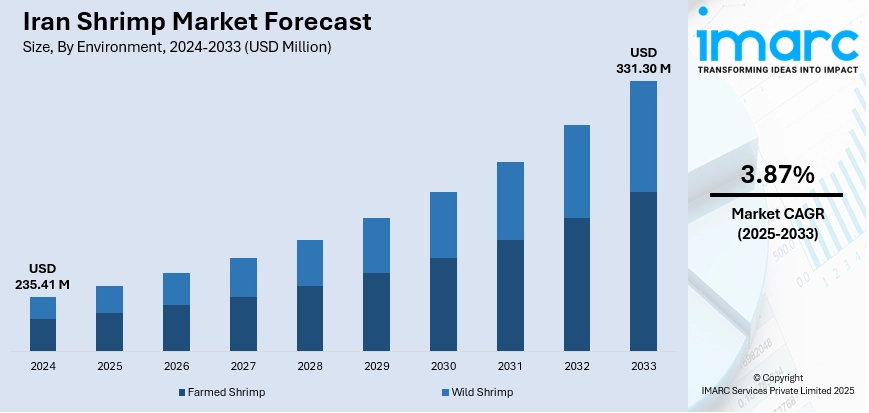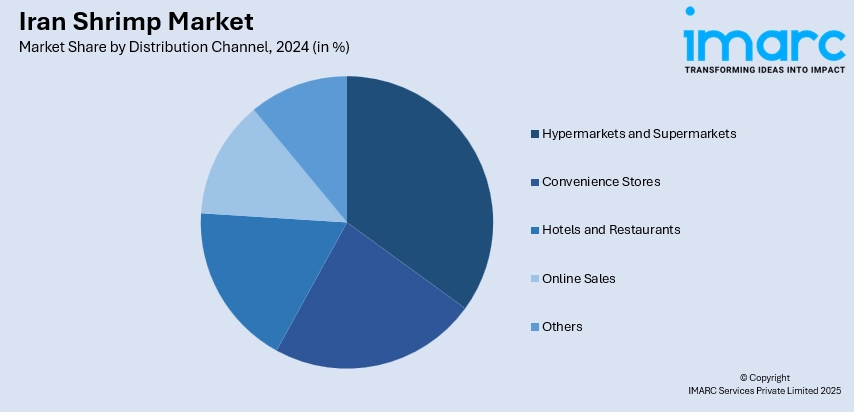
Iran Shrimp Market Size, Share, Trends and Forecast by Environment, Species, Shrimp Size, Distribution Channel, and Province, 2025-2033
Iran Shrimp Market Overview:
The Iran shrimp market size reached USD 235.41 Million in 2024. The market is projected to reach USD 331.30 Million by 2033, exhibiting a growth rate (CAGR) of 3.87% during 2025-2033. The market is growing due to rising domestic demand and expanding exports of high-quality, sustainably sourced shrimp. As the industry continues to improve farming practices and processing standards, it strengthens Iran's position in global markets, further boosting Iran shrimp market share.
|
Report Attribute
|
Key Statistics
|
|---|---|
|
Base Year
|
2024
|
|
Forecast Years
|
2025-2033
|
|
Historical Years
|
2019-2024
|
| Market Size in 2024 | USD 235.41 Million |
| Market Forecast in 2033 | USD 331.30 Million |
| Market Growth Rate 2025-2033 | 3.87% |
Iran Shrimp Market Trends:
Quality and Sustainability Increase Demand
The Iran shrimp market growth has been largely driven by the increased demand for sustainably and high-quality seafood products. As consumers around the world become more aware of the environmental cost of their diets, there is an increased trend towards ethically produced shrimp. Iranian shrimp farmers are increasingly shifting towards responsible aquaculture practices in order to satisfy both local and overseas markets. These practices encompass decreasing water usage, lowering the use of chemicals, and employing environmentally friendly feed, all of which contribute to maintaining the sustainability of shrimp farming activities. The market is also being positively impacted by better processing standards, where Iranian producers are enhancing their infrastructure to increase product quality and comply with international export standards. These enhancements involve better temperature management during shipping, improved packaging techniques to maintain freshness, and more efficient production techniques. The increasing emphasis on quality is enabling Iranian shrimp to make a greater presence felt in the international markets, particularly in countries where high-quality products are in high demand. With such enhancements, Iran will continue to experience growth in the export of shrimp and establish itself as a competitive force in the international seafood market.

To get more information on this market, Request Sample
Rising Export and Domestic Consumption
Growing demand for shrimp, both within and out of the country, is a key impetus for the shrimp industry of Iran. Increasingly, the domestic market for shrimp has grown, fueled by greater consumption levels and growing awareness of the nutritional value of seafood. Shrimp in particular has been on the rise as an all-around food which is protein-based and easy to cook and which integrates into almost any classic or contemporary dish. As local demand increases, manufacturers are attempting to increase the scale of their operations in order to address the increased demand. Export markets are also demonstrating strong interest, specifically neighboring nations and international markets that value high-quality, sustainably cultivated shrimp. The Iranian government has aided this increase by creating policies to assist shrimp farmers in expanding their operations as well as upgrading infrastructure. Export pacts and alliances with key international seafood markets are further building the industry's profile. These trends are most visible within the Gulf area, with Iranian shrimp becoming more sought after due to its high quality and competitive price. While local demand and exports are increasingly on the upswing, the industry stands to play a major role in Iran's seafood export incomes.
Iran Shrimp Market Segmentation:
IMARC Group provides an analysis of the key trends in each segment of the market, along with forecasts at the country and regional level for 2025-2033. Our report has categorized the market based on environment, species, shrimp size, and distribution channel.
Environment Insights:
- Farmed Shrimp
- Wild Shrimp
The report has provided a detailed breakup and analysis of the market based on the environment. This includes farmed shrimp and wild shrimp.
Species Insights:
- Penaeus Vannamei
- Penaeus Monodon
- Macrobrachium Rosenbergii
- Others
The report has provided a detailed breakup and analysis of the market based on the species. This includes penaeus vannamei, penaeus monodon, macrobrachium rosenbergii, and others.
Shrimp Size Insights:
- <21
- 21-25
- 26-30
- 31-40
- 41-50
- 51-60
- 61-70
- >70
The report has provided a detailed breakup and analysis of the market based on the shrimp size. This includes <21, 21-25, 26-30, 31-40, 41-50, 51-60, 61-70, and >70.
Distribution Channel Insights:

- Hypermarkets and Supermarkets
- Convenience Stores
- Hotels and Restaurants
- Online Sales
- Others
A detailed breakup and analysis of the market based on the distribution channel have also been provided in the report. This includes hypermarkets and supermarkets, convenience stores, hotels and restaurants, online sales, and others.
Provincial Insights:
- Tehran
- Khuzestan
- Bushehr
- Esfahan
- Khorasan
- Others
The report has also provided a comprehensive analysis of all the major provincial markets, which include Tehran, Khuzestan, Bushehr, Esfahan, Khorasan, and others.
Competitive Landscape:
The market research report has also provided a comprehensive analysis of the competitive landscape. Competitive analysis such as market structure, key player positioning, top winning strategies, competitive dashboard, and company evaluation quadrant has been covered in the report. Also, detailed profiles of all major companies have been provided.
Iran Shrimp Market Report Coverage:
| Report Features | Details |
|---|---|
| Base Year of the Analysis | 2024 |
| Historical Period | 2019-2024 |
| Forecast Period | 2025-2033 |
| Units | Million USD |
| Scope of the Report |
Exploration of Historical Trends and Market Outlook, Industry Catalysts and Challenges, Segment-Wise Historical and Future Market Assessment:
|
| Environments Covered | Farmed Shrimp, Wild Shrimp |
| Species Covered | Penaeus Vannamei, Penaeus Monodon, Macrobrachium Rosenbergii, Others |
| Shrimp Sizes Covered | <21, 21-25, 26-30, 31-40, 41-50, 51-60, 61-70, >70 |
| Distribution Channels Covered | Hypermarkets and Supermarkets, Convenience Stores, Hotels and Restaurants, Online Sales, Others |
| Provinces Covered | Tehran, Khuzestan, Bushehr, Esfahan, Khorasan, Others |
| Customization Scope | 10% Free Customization |
| Post-Sale Analyst Support | 10-12 Weeks |
| Delivery Format | PDF and Excel through Email (We can also provide the editable version of the report in PPT/Word format on special request) |
Key Questions Answered in This Report:
- How has the Iran shrimp market performed so far and how will it perform in the coming years?
- What is the breakup of the Iran shrimp market on the basis of environment?
- What is the breakup of the Iran shrimp market on the basis of species?
- What is the breakup of the Iran shrimp market on the basis of shrimp size?
- What is the breakup of the Iran shrimp market on the basis of distribution channel?
- What is the breakup of the Iran shrimp market on the basis of region?
- What are the various stages in the value chain of the Iran shrimp market?
- What are the key driving factors and challenges in the Iran shrimp market?
- What is the structure of the Iran shrimp market and who are the key players?
- What is the degree of competition in the Iran shrimp market?
Key Benefits for Stakeholders:
- IMARC’s industry report offers a comprehensive quantitative analysis of various market segments, historical and current market trends, market forecasts, and dynamics of the Iran shrimp market from 2019-2033.
- The research report provides the latest information on the market drivers, challenges, and opportunities in the Iran shrimp market.
- Porter's Five Forces analysis assists stakeholders in assessing the impact of new entrants, competitive rivalry, supplier power, buyer power, and the threat of substitution. It helps stakeholders to analyze the level of competition within the Iran shrimp industry and its attractiveness.
- Competitive landscape allows stakeholders to understand their competitive environment and provides an insight into the current positions of key players in the market.
Need more help?
- Speak to our experienced analysts for insights on the current market scenarios.
- Include additional segments and countries to customize the report as per your requirement.
- Gain an unparalleled competitive advantage in your domain by understanding how to utilize the report and positively impacting your operations and revenue.
- For further assistance, please connect with our analysts.
 Request Customization
Request Customization
 Speak to an Analyst
Speak to an Analyst
 Request Brochure
Request Brochure
 Inquire Before Buying
Inquire Before Buying




.webp)




.webp)












